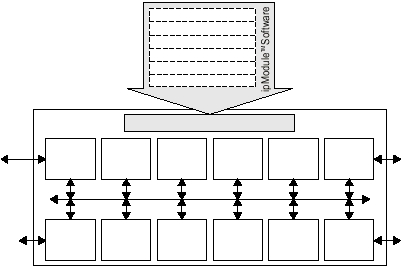PRELIMINARY
May 27, 2001
www.ubicom.com
1
1.0
Product Overview
The Ubicom IP2022 Internet Processor™ combines
support for communication physical layer, Internet
protocol stack, device-specific application, and device-
specific peripheral software modules in a single chip, and
is reconfigurable over the Internet. It can be programmed,
and reprogrammed, using pre-built software modules and
configuration tools to create true single-chip solutions for
a wide range of device-to-device and device-to-human
communication applications. Fabricated in an advanced
0.25-micron process, its RISC-based deterministic
architecture provides high-speed computation, flexible I/O
control,
efficient
data
manipulation,
in-system
programming, and in-system debugging. A hardware
serializer/deserializer (SERDES) function gives the
IP2022 the ability to connect directly to a variety of
common network interfaces. This function provides the
ability to implement on-chip 10Base-T Ethernet (MAC and
PHY), USB, and a variety of other fast serial protocols.
Two SERDES units facilitate translation from one format
to another, allowing the IP2022 to be used as a protocol
converter. The 100 MHz operating frequency, with most
instructions executing in a single cycle, delivers the
throughput needed for emerging network connectivity
applications, and a flash-based program memory allows
both in-system and on-the-fly reprogramming. The
IP2022 implements peripheral, communications and
control functions as software modules (ipModule™
software), replacing traditional hardware for maximum
system design flexibility. This approach allows rapid,
inexpensive product design and, when needed, quick and
easy reconfiguration to accommodate changes in market
needs or industry standards.
On-chip dedicated hardware also includes a PLL, an 8-
channel 10-bit ADC, general-purpose timers, single-cycle
multiplier, analog comparator, LFSR units, external
memory interface, brown-out power voltage detector,
watchdog timer, low-power support, multi-source wakeup
capability, user-selectable clock modes, high-current
outputs, and 52 general-purpose I/O pins.
A TCP/IP network protocol stack is available, and a
variety of additional software that is necessary to form a
complete end-to-end connectivity solution is being
developed. Tools for developing with and using the
IP2022, including the complete Red Hat GNUPro tools,
are available from leading suppliers.
Figure 1-1 IP2022 Block Diagram
515-063.eps
IP2022
10Base-T Ethernet
USB 1.1
GPSI
SPI
UART/Modem
Bluetooth HCI
Customer Application
HTTP/SMTP/TFTP
TCP/UDP
IP/ICMP
Network Access Layer
PHY Firmware
ipOS Operating System
High-Speed
Serial Unit 2
(SERDES)
ISP/ISD
Interface
8-Input
10-Bit
A/DC
PLL
Clock
Multiplier
5
Timers
High-Speed
Serial Unit 1
(SERDES)
General
Purpose
I/O Ports
4-Kbyte
Data
RAM
16-Kbyte
Inst./Data
RAM
64-Kbyte
Flash
Memory
Internet
Processor
CPU
8/16-Bit
Parallel
Slave Port
ISA
I2C
General-Purpose I/O
Choices for
Communication:
10Base-T
Ethernet
USB 1.1
GPSI
SPI
UART/Modem
Bluetooth HCI
Host Bus
Choices for
Communication:
IP2022 Internet Processor™
Features and Performance Optimized for Network Connectivity

